Kingsgrove Branch:
Green Wall Plugs

G'day! You're in the shed, ready to hang that new shelf, mount a TV bracket, or fix a hose reel to the side of the house. You're faced with a good, solid Aussie brick or concrete wall. You know you can't just whack a screw straight into it – it'll just spin and fall out, leaving a knackered, useless hole.
To do the job right, you need an anchor. And the one you'll find in every tradie's tool bag and every Aussie's junk drawer is the humble, hard-working green wall plug.
It's a fair dinkum legend of the worksite, but what's the go with it? And why is it green?
So, What is a Green Wall Plug, Exactly?
A green wall plug is a simple plastic (or nylon) insert that you put into a drilled hole in a masonry wall. It's designed to expand when you drive a screw into it. This expansion provides a massive, vice-like grip against the inside of the hole, giving your screw something solid to bite into.
Why Green, Mate? The Colour Code
That colour isn't just for looks; it's a size guide. While a few brands might differ, in Australia, the classic green wall plug is the go-to, medium-duty workhorse.
- It's the "7mm" Plug: It's designed to be used with a 6.5mm or 7mm masonry drill bit.
- It's for 8-10 Gauge Screws: It's the perfect partner for your standard 8G or 10G (Gauge) screws.
It's the "Goldilocks" size – not too small, not too big. It's tough enough for most jobs around the house that a little red or yellow plug can't handle.
The Big Mistake: Don't Use 'Em in Plasterboard!
Righto, let's get this straight. Wall plugs are for solid walls only. We're talking:
- Brick
- Concrete
- Render
- Stone
- Besser blocks
If you try and use one of these in plasterboard (Gyprock), it'll just spin and rip a massive hole when you put any weight on it. You need a proper, dedicated plasterboard anchor (like a Wall Mate or a toggle) for that job.
How to Use Green Wall Plugs Like a Pro
Getting a rock-solid fixing is dead easy if you follow the steps and don't be a galah.
- Get the Right Bit: You must use a masonry drill bit (the one with the tough carbide tip). For a green wall plug, this is usually a 6.5mm or 7mm bit.
- Use the Hammer Drill: Flick your drill onto the 'hammer' setting. This is non-negotiable for brick or concrete.
- Drill the Hole: Drill your hole slightly deeper than the length of the plug. This gives the dust and the screw tip somewhere to go.
- Clean the Hole (The Pro Tip): This is the bit most amateurs skip. The hole will be full of brick dust, which stops the plug from gripping properly. Give it a good blow-out (put your safety glasses on first!) or use a vacuum.
- Tap it in: The plug should be a snug fit. Gently tap it in with a hammer until it's 'flush' with the wall.
- Send it Home: Line up your bracket, get your 8G or 10G screw, and drive it in. You'll feel it bite and get proper tight. Don't overtighten and strip it! Job done.
A Professional Job Needs Professional Gear
Knowing how to use green wall plugs is a top skill. But for a licensed professional – like an electrician installing a new switchboard or a heavy-duty air con unit – a "she'll be right" fitting isn't good enough. They need to guarantee that a 20kg bit of kit isn't going to pull off the wall.
This is why they source their fasteners and all their gear from a trusted electrical wholesaler. They know a good electrical wholesaler stocks the trade-quality, heavy-duty anchors and green wall plugs that are rated for the job, not just the cheap, brittle ones from a discount bin.
As one of Australia's most comprehensive electrical wholesaler and supplier networks, Schnap Electric Products stocks the lot for the professional installer. From the heavy-duty green wall plugs and masonry anchors a tradie needs, to the high-quality switchboards, conduits, and power points they're actually fixing to the wall. For a job that's safe, compliant, and built to last, the pros rely on a supplier like Schnap Electric.
Recent posts

Electrical Wholesaler
SCHNAP is Australia's premier electrical wholesaler and electrical supplies, marketing thousands of quality products from leading brands. Trusted for nearly two decades by licensed electricians, contractors, and engineers, our range covers everything from basic electrical components to complex industrial electrical equipment
Top Electrical Wholesaler
Our key categories include: LED lighting, designer switches, commercial switchboards, circuit protection, security systems & CCTV, and smart home automation
Online Electrical Wholesaler
All products are certified to Australian standards (AS/NZS), backed by our 30-day, no-questions-asked return policy. Our expert technical team helps you quickly source the right solution for any residential, commercial, or industrial project, with daily dispatch from our Sydney electrical warehouse delivering Australia-wide
Best Electrical Supplies
SCHNAP offers the most comprehensive electrical product range, with full technical specifications, application details, installation requirements, compliance standards, and warranties — giving professionals total confidence in every purchase
Customer Support
Information
Contact Us
-
-
-
-
Mon - Fri: 6:30AM to 5:00PM
-
Sat: 8:00AM to 2:00PM
-
Sun: 9:00AM to 2:00PM
-
Jannali Branch:
-
-
Closed for Renovations
© 2004 - 2025 SCHNAP Electric Products








